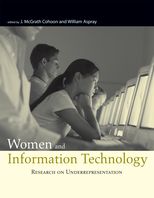 Women and Information Technology: Research on Underrepresentation
Women and Information Technology: Research on Underrepresentation
Contents
-
-
-
-
-
-
-
-
-
The Nontraditional Student in IT/CS The Nontraditional Student in IT/CS
-
The AAAS/CPST Study of Nontraditional Pathways into the IT/CS Workforce The AAAS/CPST Study of Nontraditional Pathways into the IT/CS Workforce
-
Student Demographics Student Demographics
-
Educational Backgrounds Educational Backgrounds
-
Reasons for Choosing IT/CS Reasons for Choosing IT/CS
-
Reasons for Choosing Institutions Reasons for Choosing Institutions
-
Educational Experiences Educational Experiences
-
Satisfaction Satisfaction
-
Financing Financing
-
Postgraduation Educational Plans and Experiences Postgraduation Educational Plans and Experiences
-
Teaching the Nontraditional Student Teaching the Nontraditional Student
-
Perceptions of the Field Perceptions of the Field
-
Perceptions about Students Perceptions about Students
-
Weed-Out Courses Weed-Out Courses
-
Recruitment Efforts Recruitment Efforts
-
Awareness of Nontraditional Students Awareness of Nontraditional Students
-
Characteristics and Needs of Nontraditional Students Characteristics and Needs of Nontraditional Students
-
Conclusions Conclusions
-
Notes Notes
-
References References
-
-
-
-
-
-
-
-
-
-
-
8 The Poverty of the Pipeline Metaphor: The AAAS/CPST Study of Nontraditional Pathways into IT/CS Education and the Workforce
Get access-
Published:February 2006
Cite
Abstract
This chapter discusses the American Association for the Advancement of Science/Commission on Professionals in Science and Technology (AAAS/CPST) study of nontraditional pathways into the information technology and computer science (IT/CS) workforce. A “nontraditional pathway” is defined as the path taken by a nontraditional student, i.e., someone who: delays enrollment at least three years after graduating from high school or earning a GED; attends college mostly part-time; takes longer than six years to complete a degree; is employed full-time during most of their studies; or has dependents while attending college. Researchers interviewed 72 IT/CS faculty and 139 IT/CS students at the twenty institutions. The study found that the same variables that prevent women and minorities from choosing IT/CS education are compounded for nontraditional students who want to attend traditional universities.
Sign in
Personal account
- Sign in with email/username & password
- Get email alerts
- Save searches
- Purchase content
- Activate your purchase/trial code
- Add your ORCID iD
Purchase
Our books are available by subscription or purchase to libraries and institutions.
Purchasing information| Month: | Total Views: |
|---|---|
| October 2023 | 3 |
| August 2024 | 1 |
| December 2024 | 3 |


Get help with access
Institutional access
Access to content on Oxford Academic is often provided through institutional subscriptions and purchases. If you are a member of an institution with an active account, you may be able to access content in one of the following ways:
IP based access
Typically, access is provided across an institutional network to a range of IP addresses. This authentication occurs automatically, and it is not possible to sign out of an IP authenticated account.
Sign in through your institution
Choose this option to get remote access when outside your institution. Shibboleth/Open Athens technology is used to provide single sign-on between your institution’s website and Oxford Academic.
If your institution is not listed or you cannot sign in to your institution’s website, please contact your librarian or administrator.
Sign in with a library card
Enter your library card number to sign in. If you cannot sign in, please contact your librarian.
Society Members
Society member access to a journal is achieved in one of the following ways:
Sign in through society site
Many societies offer single sign-on between the society website and Oxford Academic. If you see ‘Sign in through society site’ in the sign in pane within a journal:
If you do not have a society account or have forgotten your username or password, please contact your society.
Sign in using a personal account
Some societies use Oxford Academic personal accounts to provide access to their members. See below.
Personal account
A personal account can be used to get email alerts, save searches, purchase content, and activate subscriptions.
Some societies use Oxford Academic personal accounts to provide access to their members.
Viewing your signed in accounts
Click the account icon in the top right to:
Signed in but can't access content
Oxford Academic is home to a wide variety of products. The institutional subscription may not cover the content that you are trying to access. If you believe you should have access to that content, please contact your librarian.
Institutional account management
For librarians and administrators, your personal account also provides access to institutional account management. Here you will find options to view and activate subscriptions, manage institutional settings and access options, access usage statistics, and more.